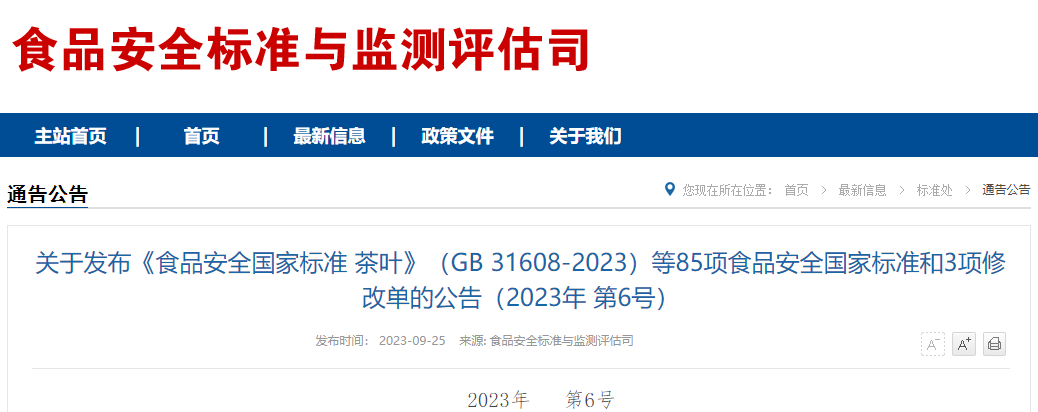
On September 25, 2023, the National Health Commission (NHC) released announcement No. 6, 2023 regarding 85 national food safety standards, including National Food Safety Standard - Tea (GB 31608-2023), along with three modification documents.
Among these standards,17are related to food contact materials, includingfivefor food contact materials products standards,twogeneral principles, andteninspection methods.Of particular importance is the introduction of a new food contact ink standard. Additionally, revisions have been made to existing standards pertaining to food-contact plastics, metals, rubber, and composite materials. These updates further clarify the management principles and requirements and the approved use of fundamental materials, aiming to bolster food safety, ensure consumers’ well-being, and address practical industry concerns.
Specific regulations are as follows:
Standards for food contact materials and products
Standard Number |
Standard Name |
Date of Implementation |
Substitute Standard |
GB 4806.7-2023 |
2024.9.6 |
GB 4806.6-2016, GB 4806.7-2016, and plastic resins recorded in relevant announcements issued by NHC (former NHFPC) |
|
GB 4806.9-2023 |
GB 4806.9-2016 |
||
GB 4806.11-2023 |
GB 4806.11-2016 and rubber basic raw materials recorded in relevant announcements issued by NHC (former NHFPC) |
||
GB 4806.13-2023 |
National Food Safety Standard - Food Contact Composite Materials |
GB 9683-1988 |
|
GB 4806.14-2023 |
New standard |
General principles for food contact materials and products
Standard Number |
Standard Name |
Date of Implementation |
Substitute Standard |
GB 31604.1-2023 |
National Food Safety Standard - General Principles for Food Contact Materials Migration Tests |
2024.9.6 |
GB 31604.1-2015 |
GB 31604.59-2023 |
National Food Safety Standard - General Principles for Validation of Chemical Analysis Methods for Food Contact Materials and Products |
New standard |
Standards for inspection methods of food contact materials and products
Standard Number |
Standard Name |
Date of Implementation |
Substitute Standard |
|---|---|---|---|
GB 31604.7-2023 |
National Food Safety Standard - Food Contact Materials and Products Decoloration Tests |
2024.3.6 |
GB 31604.7-2016 |
GB 31604.29-2023 |
National Food Safety Standard - Determination of Migration of Food Contact Acrylic Acid, Methacrylic Acid, and Their Esters |
GB 31604.29-2016 |
|
GB 31604.46-2023 |
National Food Safety Standard - Determination of Food Contact Free Phenol and Migration of Phenolic Compounds |
GB 31604.46-2016 |
|
GB 31604.47-2023 |
National Food Safety Standard - Determination of Food Contact Paper, Paperboard, and Fluorescent Substances in Paper Products |
GB 31604.47-2016 |
|
GB 31604.49-2023 |
National Food Safety Standard - Determination of Food Contact Multielements and Multielement Migration |
GB 31604.49-2016 |
|
GB 31604.54-2023 |
National Food Safety Standard - Determination of Food Contact Bisphenol F and Bisphenol S Migration |
New standard |
|
GB 31604.55-2023 |
National Food Safety Standard - Determination of Food Contact Isothiazolinone Compounds Migration |
||
GB 31604.56-2023 |
National Food Safety Standard - Determination of Food Contact Lauramide Migration |
||
GB 31604.57-2023 |
National Food Safety Standard - Determination of Food Contact Benzophenone-type Substances Migration |
||
GB 31604.58-2023 |
National Food Safety Standard - Determination of 9 Food Contact Antioxidants Migration |
Major changes in the five updated standards for food contact materials and products
GB 4806.7-2023 National Food Safety Standard - Food Contact Plastics |
|
GB 4806.9-2023 National Food Safety Standard - Food Contact Metals |
|
GB 4806.11-2023 National Food Safety Standard - Food Contact Rubber |
|
GB 4806.13-2023 National Food Safety Standard - Food Contact Composite Materials |
|
GB 31604.1-2023 National Food Safety Standard - General Principles for Food Contact Materials Migration Tests |
|
If you need any assistance or have any questions, please contact us viatest@cirs-group.com.
